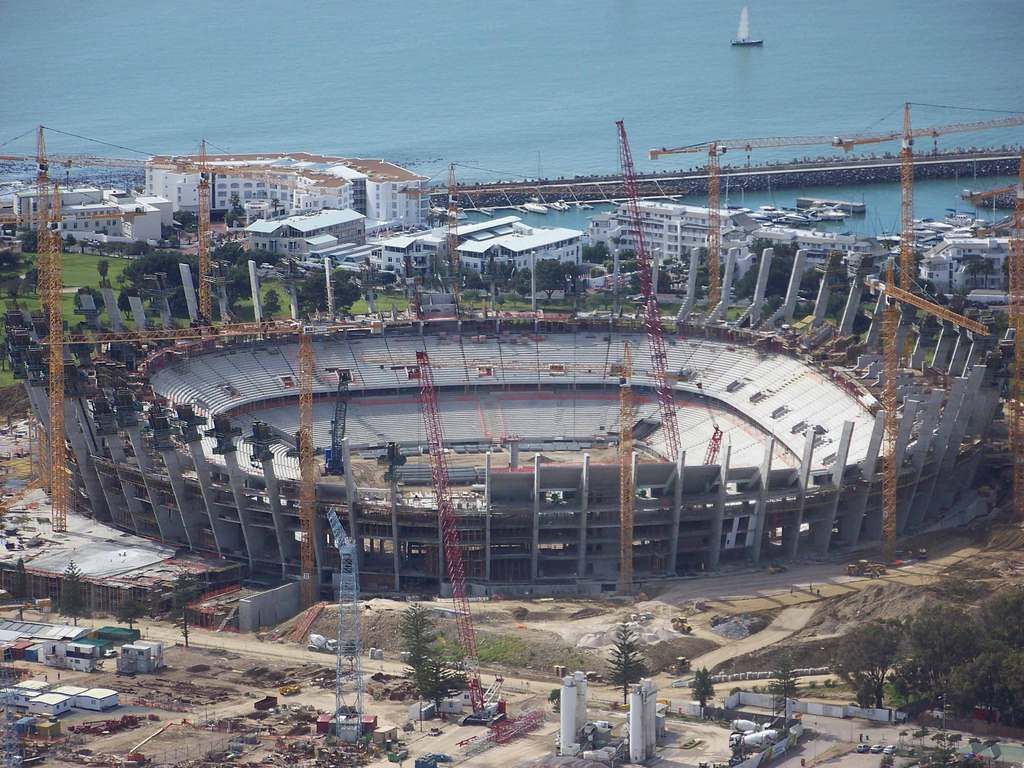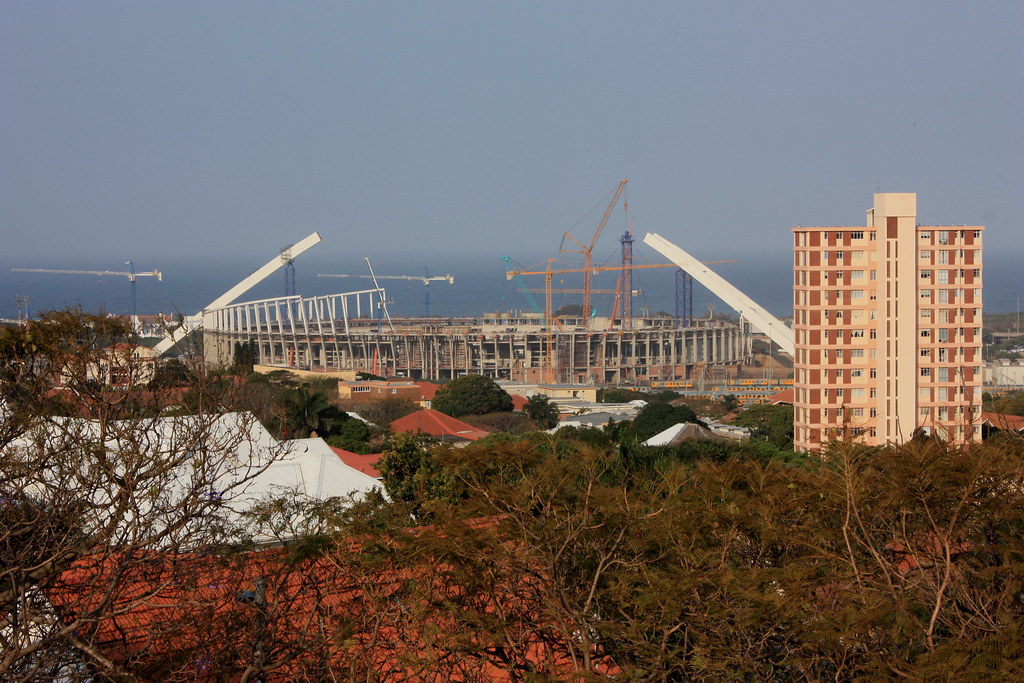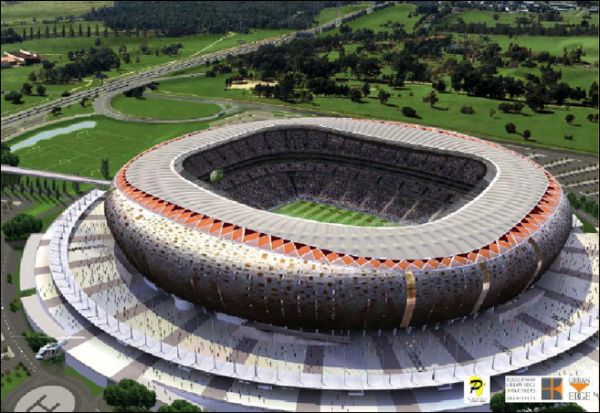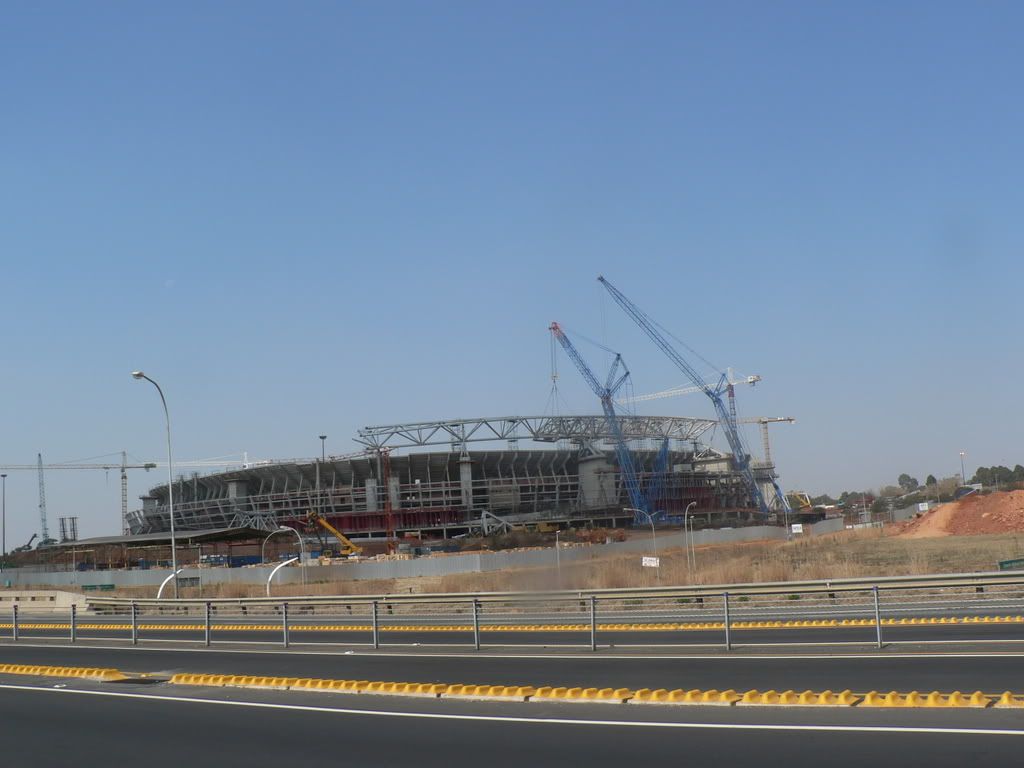South Africa 2010. Some may think of this event as a curse where we show just how 3rd world we are. Many believe we'll fail. And this may happen. Bafana may, and most probably will, be knocked out in the first round. Sure, a catastrophe for the success of the tournament. There may be an incident, an attack on a foreigner. These are the perils of being in the international eye. One incident is magnified 1000x because of the focus of the world being on South Africa. This may all happen, but one thing is a given. After the 2010 World Cup we will have some of the best transport, air, hotel and stadium infrastructure in the world. This site's focus is stadia so I will be giving some in depth information on the stadia being built and renovated. All 10 to host 64 world cup matches. Here we go:
Green Point Stadium
Being built from scratch. There was much controversy at the beginning of this stadium's construction. Environmental groups labelled it an eye-sore. Architects had to come up with a design that would be of the least impact to the natural surroundings, they came up with this. A concave roof, bending inwards, glass. The outer facade linking to the down bending roof. Facade covered in a white ETFE membrane. The visual effect of the top of the stadium is that of simplicity and elegance, linking it to the clouds atop table mountain. The wavy motion of the compression ring (what holds the roof in place) above the facade is a beautiful, simplistic image.
The interior, three tiers of seating, 68 000 seats. Each seat having excellent sight lines. Will probably be the best sport viewing stadium in the world when complete.
Watch this video to get a true idea of the spectacular Green Pont Stadium
Moses Mabhida Stadium
Another new stadium. Will probably be the most spectacular looking stadium in the world when complete. The arches are already changing Durban's skyline for good. The white arches, 350m long, 106m high, act as a symbol for unity and the 'y' shape reminds one of the South African flag. The roof, a 46 000 square metre teflon coated glass-fibre membrane. The facade, aluminium cladding around 550 aluminium 'fins'. The interior. 70 000 seats in a 3 tiered bowl. Again excellent sight-lines to view an unforgettable sight
Nelson Mandela Bay Stadium
 The jewel of Port Elizabeth. 36 aluminium roof trusses, cladded with a perforated aluminium membrane. These trusses linked together by the same ETFE memebrane used in Cape Town. Inside, a two tiered bowl of 48 000 seats. Two 12.7x7.2m big screens.
The jewel of Port Elizabeth. 36 aluminium roof trusses, cladded with a perforated aluminium membrane. These trusses linked together by the same ETFE memebrane used in Cape Town. Inside, a two tiered bowl of 48 000 seats. Two 12.7x7.2m big screens.
Mbombela Stadium
 A new stadium being built outside Nelspruit. The Mbombela Stadium is being built in close proximity to the Kruger National Park, and this inter-relationship is shown by the giraffe roof supports (the neck sticking out above the roof). This is an extremely clever and effective architectural design. The facade is plain and affective. The interior, a two tiered, 46 000 seater bowl covered by a cantilever roof. The stands, close to the action in a rounded rectangular shape. The roof, as you can see is lifted quite high above the stands. This is to accentuate the African, open air feeling. All in all, a truly amazing African stadium.
A new stadium being built outside Nelspruit. The Mbombela Stadium is being built in close proximity to the Kruger National Park, and this inter-relationship is shown by the giraffe roof supports (the neck sticking out above the roof). This is an extremely clever and effective architectural design. The facade is plain and affective. The interior, a two tiered, 46 000 seater bowl covered by a cantilever roof. The stands, close to the action in a rounded rectangular shape. The roof, as you can see is lifted quite high above the stands. This is to accentuate the African, open air feeling. All in all, a truly amazing African stadium.
Peter Mokaba Stadium
 The Peter Mokaba Stadium is a new stadium being built in Polokwane, Limpopo province. Again, clever architecture has been used. The 4 large structures in each corner are roof and floodlight supports. They are also a depiction of the baobab tree, a common tree in this part of South Africa. As in the Mbombela Stadium, this is a very apt inter-relationship. Despite having only a grandstand roof (the thinking was that in this area of Africa, not much of a roof would be needed because of the generally great weather) the interior is simple yet effective. 2 tiers in a concave shaped bowl providing excellent sight lines for football and rugby.
The Peter Mokaba Stadium is a new stadium being built in Polokwane, Limpopo province. Again, clever architecture has been used. The 4 large structures in each corner are roof and floodlight supports. They are also a depiction of the baobab tree, a common tree in this part of South Africa. As in the Mbombela Stadium, this is a very apt inter-relationship. Despite having only a grandstand roof (the thinking was that in this area of Africa, not much of a roof would be needed because of the generally great weather) the interior is simple yet effective. 2 tiers in a concave shaped bowl providing excellent sight lines for football and rugby.

Soccer City
 The calabash. Another African stadium designed to look like the traditional African calabash pot. 95 000 seats in a 3 tiered bowl with excellent sight lines to watch a world cup final. What more can you ask for
The calabash. Another African stadium designed to look like the traditional African calabash pot. 95 000 seats in a 3 tiered bowl with excellent sight lines to watch a world cup final. What more can you ask for

Free State Stadium
Built in Bloemfontein and home to the Free State Cheetahs. A second tier is currently being added to the grand stand. When complete a fully fledged two tiered stadium, seating 46 000 people with stands close to the action.
Ellis Park Stadium
The premier stadium in South Africa and home to Springbok rugby. Has recently had a tier added to the Northern side of the stadium. An extra 5000 seats added. An amazing venue ready for amazing matches.
Loftus Versfeld Stadium
Is currently having a new roof installed aver the main open pavilion. This installation will bring the stadium up to Fifa standards and make it ready to host the 2010 Soccer World Cup. At the moment, seats 51 000 people.
A picture of the stadium before renovation. The roof is currently being lifted into pace on the far open stand.
Royal Bafokeng Stadium
Recent host of a rugby test match between South Africa and New Zealand. Renovations currently underway to extend the seating and add a new roof over the grand stand.
What the stadium will look like when complete
So that lines up the ten host stadia for the 2010 showpiece. I'd say the best ever set of stadia put together for one sporting tournament. Hopefully in a year's time, I'll be showing you finished products rather than renders of what the future will look like. Here's to construction and progress.
 The closing gap. The complete first and second tier bowl now formed.
The closing gap. The complete first and second tier bowl now formed. The templates where sections that last time were on them are now on the ground again.
The templates where sections that last time were on them are now on the ground again. Lake side of the stadium. The white sand on the ground is a track for the massive Kobelco crane (used to lift the roof) to run on.
Lake side of the stadium. The white sand on the ground is a track for the massive Kobelco crane (used to lift the roof) to run on. A closer view of the lake side of the stadium. The window frames are being installed.
A closer view of the lake side of the stadium. The window frames are being installed. The stadium across the lake. Note the massive Kobelco crane on the left.
The stadium across the lake. Note the massive Kobelco crane on the left.











































